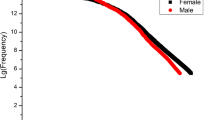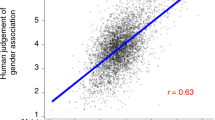Abstract
Using latent semantic analysis, we examined gender stereotypes in American English by submitting over 100 masculine, neutral, and feminine role-words and trait-words to pair-wise semantic similarity comparisons with masculine (man, he, him) and feminine (woman, she, her) referents separately. We expected to find: (a) Stereotyping—roles and traits would be more semantically similar to the ostensible ‘matching’ than ‘mismatching’ gender category referent; (b) Categorical narrowness—both categories would be less semantically similar to counterstereotypical than to neutral or stereotypical characteristics; but this would be especially so for the male category, indicating its relatively greater narrowness. Results supported these hypotheses, but only among role-words. American English reflects and reinforces gender stereotypes regarding gender roles at a level beyond that recognized previously.

Similar content being viewed by others
References
American National Corpus. (2007). Retrieved May 19, 2008, from http://americannationalcorpus.org/SecondRelease/frequency2.html.
Anderson, C. A., & Sedikides, C. (1991). Contributions of a typological approach to associationistic and dimensional views of person perception. Journal of Personality and Social Psychology, 60, 203–217.
Bem, S. L. (1974). The measurement of psychological androgyny. Journal of Consulting and Clinical Psychology, 42, 155–162.
Berry, M. W., Dumais, S. T., & Letsche, T. A. (1995, December). Computational methods for intelligent information access. In Paper presented at the Proceedings of Supercomputing. San Diego, CA. Retrieved February 23, 2007 from http://www.cs.utk.edu/∼berry/sc95/sc95.html.
Beyer, S. (1999). The accuracy of academic gender stereotypes. Sex Roles, 40, 787–813.
Biernat, M. (1991). Gender stereotypes and the relationship between masculinity and femininity: A developmental analysis. Journal of Personality and Social Psychology, 61, 351–365.
Blair, I. V., & Banaji, M. R. (1996). Automatic and controlled processes in stereotype priming. Journal of Personality and Social Psychology, 70, 1142–1163.
Blair, I. V., Ma, J. E., & Lenton, A. P. (2001). Imagining stereotypes away: The moderation of implicit stereotypes through mental imagery. Journal of Personality and Social Psychology, 81, 828–841.
Bosson, J. K., Prewitt-Freilino, J. L., & Taylor, J. N. (2005). Role rigidity: A problem of identity misclassification? Journal of Personality and Social Psychology, 89, 552–565.
British National Corpus (2001). The British National Corpus. version 2 (BNC World). Distributed by Oxford University Computing Services on behalf of the BNC Consortium. Retrieved February 21, 2007, from http://view.byu.edu/.
Burn, S. M. (2000). Heterosexuals’ use of “fag” and “queer” to deride one another: A contributor to heterosexism and stigma. Journal of Homosexuality, 40, 1–11.
Campbell, R. S., & Pennebaker, J. W. (2003). The secret life of pronouns: Flexibility in writing style and physical health. Psychological Science, 14, 60–65.
Carroll, J. B. (1956). Introduction. In J. B. Carroll (Ed.), B. L. Whorf, Language, thought and reality: Selected writings of Benjamin Lee Whorf. Cambridge, MA: MIT.
Deerwester, S. C., Dumais, S. T., Landauer, T. K., Furnas, G. W., & Harshman, R. A. (1990). Indexing by latent semantic analysis. Journal of the American Society for Information Science American Society for Information Science, 41, 391–407.
Dennis, S., Landauer, T., Kintsch, W., & Quesada, J. (2003). Introduction to latent semantic analysis. Slides from the tutorial given at the 25th Annual Meeting of the Cognitive Science Society, Boston. Retrieved February 27, 2007 from http://lsa.colorado.edu/%7Esimon/LSATutorial.pdf.
Diekman, A. B., & Eagly, A. H. (2000). Stereotypes as dynamic constructs: Women and men of the past, present, and future. Personality and Social Psychology Bulletin, 26, 1171–1181.
Eagly, A. H., & Steffen, V. J. (1984). Gender stereotypes stem from the distribution of women and men into social roles. Journal of Personality and Social Psychology, 46, 735–754.
Eagly, A. H., Wood, W., & Diekman, A. B. (2000). Social role theory of sex differences and similarities: A current appraisal. . In T. Eckes & H. M. Trautner (Eds.), The developmental social psychology of gender (pp. 123–174). Mahwah, NJ: Erlbaum.
Ernst, S. B. (1995). Gender issues in books for children and young adults. In S. Lehr (Ed.), Battling dragons: Issues and controversy in children’s literature (pp. 66–78). Portsmouth, NH: Heinemann.
Gastil, J. (1990). Generic pronouns and sexist language: The oxymoronic character of masculine generics. Sex Roles, 23, 629–643.
Glenberg, A. M. (1997). What memory is for. The Behavioral and Brain Sciences, 20, 1–55.
Glenberg, A. M., & Robertson, D. A. (2000). Symbol grounding and meaning: A comparison of high-dimensional and embodied theories of meaning. Journal of Memory and Language, 43, 379–401.
Global Reach (2004). Global Internet statistics: Sources and references. Retrieved July 22, 2008 from http://www.glreach.com/globstats/refs.php3.
Graddol, D. (2000). The future of English? A guide to forecasting the popularity of the English language in the 21st century. London, England: The British Council. Retrieved July 22, 2008 from http://www.britishcouncil.org/de/learning-elt-future.pdf.
Helgeson, V. S. (1994). Prototypes and dimensions of masculinity and femininity. Sex Roles, 31, 653–682.
Hense, R. L., Penner, L. A., & Nelson, D. A. (1995). Implicit memory for age stereotypes. Social Cognition, 13, 399–415.
Judd, C. M., & Park, B. (1993). Definition and assessment of accuracy in social stereotypes. Psychological Review, 100, 109–128.
Kahneman, D., & Miller, D. T. (1986). Norm theory: Comparing reality to its alternatives. Psychological Review, 93, 136–153.
Kennison, S. M., & Trofe, J. L. (2003). Comprehending pronouns: A role for word-specific gender stereotype information. Journal of Psycholinguistic Research, 32, 355–378.
Kontostathis, A., & Pottenger, W. M. (2002). A mathematical view of latent semantic indexing: Tracing term co-occurrences. Technical Report, LU-CSE-02-006, Department of Computer Science and Engineering, Lehigh University. Retrieved 16 September, 2007 from http://www3.lehigh.edu/engineering/cse/research/reports/2002.asp.
Laham, D. (1997). Latent semantic analysis approaches to categorization. In M. G. Shafto & P. Langley (Eds.), Proceedings of the 19th annual meeting of the Cognitive Science Society (p. 979). Mahwah, NJ: Erlbaum Retrieved March 1, 2007 from: http://lsa.colorado.edu/.
Landauer, T. K. (2002). On the computational basis of learning and cognition: Arguments from LSA. In N. Ross (Ed.), The psychology of learning and motivation, 41 (pp. 43–84). New York: Academic.
Landauer, T. K., & Dumais, S. T. (1997). A solution to Plato’s problem: The Latent semantic analysis theory of the acquisition, induction, and representation of knowledge. Psychological Review, 104, 211–240.
Landauer, T. K., Foltz, P. W., & Laham, D. (1998a). Introduction to latent semantic analysis. Discourse Processes, 25, 259–284.
Landauer, T. K., Laham, D., & Derr, M. (2004). From paragraph to graph: Latent semantic analysis for information visualization. Proceedings of the National Academy of Sciences of the United States of America, 101, 5214–5219.
Landauer, T. K., Laham, D., & Foltz, P. W. (1998b). Learning human-like knowledge by singular value decomposition: A progress report. In M. I. Jordan, M. J. Kearns, & S. A. Solla (Eds.), Advances in neural information processing systems, 10 (pp. 45–51). Cambridge: MIT.
Landauer, T. K., Laham, D., Rehder, B., & Schreiner, M. E. (1997). How well can passage meaning be derived without using word order? A comparison of latent semantic analysis and humans. In M. G. Shafto & P. Langley (Eds.), Proceedings of the 19th annual meeting of the Cognitive Science Society (pp. 412–417). Mahwah, NJ: Erlbaum.
Lemaire, B., & Denhière, G. (2006). Effects of high-order co-occurrences on word semantic similarity. Current Psychology Letters: Behaviour, Brain & Cognition, 18.
Lenton, A. P., & Webber, L. (2006). Cross-sex friendships: Who has more? Sex Roles, 54, 809–820.
Lippa, R., & Connelly, S. (1990). Gender diagnosticity: A new Bayesian approach to gender-related individual differences. Journal of Personality and Social Psychology, 59, 1051–1065.
Maass, A., Salvi, D., Arcuri, L., & Semin, G. (1989). Language use in intergroup contexts: The linguistic intergroup bias. Journal of Personality and Social Psychology, 57, 981–993.
Maccoby, E. (1998). The two sexes: Growing up apart, coming together. Cambridge, MA: Harvard University Press.
Prentice, D. A., & Carranza, E. (2002). What women and men should be, shouldn’t be, are allowed to be, and don’t have to be: The contents of prescriptive gender stereotypes. Psychology of Women Quarterly, 26, 269–281.
Queller, S. (2002). Stereotype change in a recurrent network. Personality and Social Psychology Review, 6, 295–303.
Queller, S., & Smith, E. R. (2002). Subtyping versus bookkeeping in stereotype learning and change: Connectionist simulations and empirical findings. Journal of Personality and Social Psychology, 82, 300–313.
Rodler, C., Kirchler, E., & Holzl, E. (2001). Gender stereotypes of leaders: An analysis of the contents of obituaries from 1974 to 1998. Sex Roles, 45, 827–844.
Schiffman, S. S., Reynolds, M. L., & Young, F. W. (1981). Introduction to multidimensional scaling: Theory, methods, and applications. San Diego, CA: Academic.
Smith, E. R., & Conrey, F. R. (2007). Mental representations as states not things: Implications for implicit and explicit measurement. In B. Wittenbrink, & N. Schwarz (Eds.), Implicit measures of attitudes (pp. 247–264). New York, NY: Guilford.
Smith, E. R., & DeCoster, J. (1998). Knowledge acquisition, accessibility, and use in person perception and stereotyping: Simulation with a recurrent connectionist network. Journal of Personality and Social Psychology, 74, 21–35.
Touchstone Applied Science & Associates (TASA) Inc. (2006). Word frequency guide. Retrieved January 22, 2008, from http://www.tasaliteracy.com/wfg/wfg-main.html.
Watt, N., & Gow, D. (March 25, 2006). Chirac vows to fight the growing use of English. Guardian News and Media Limited 2008. Retrieved July 22, 2008 from http://www.guardian.co.uk/world/2006/mar/25/france.eu.
Wolfe, M. B. W., & Goldman, S. R. (2003). Use of latent semantic analysis for predicting psychological phenomena: Two issues and proposed solutions. Behavior Research Methods, 35, 22–31.
Author information
Authors and Affiliations
Corresponding author
Additional information
The research reported herein was supported by Economic and Social Research Council grant #RES-000-22-0253.
Appendix
Appendix
The feminine, neutral, and masculine role- and trait-words submitted to latent semantic analysis
Roles | Traits | |
Feminine | Beautician | Affectionate |
Caregiver | Caring | |
Cheerleader | Cheerful | |
Dancer | Compassionate | |
Decorator | Delicate | |
Designer | Emotional | |
Dietician | Flatterable | |
Florist | Gentle | |
Hairdresser | Gossipy | |
Homemaker | Humble | |
Housekeeper | Loyal | |
Model | Moody | |
Nanny | Nagging | |
Nurse | Polite | |
Receptionist | Sensitive | |
Stylist | Shy | |
Typist | Sympathetic | |
Tender | ||
Understanding | ||
Warm | ||
Neutral | Assistant | Adaptable |
Cashier | Candid | |
Clerk | Childlike | |
Doctor | Conceited | |
Editor | Conscientious | |
Lawyer | Conventional | |
Poet | Earnest | |
Reporter | Forward | |
Servant | Friendly | |
Worker | Gullible | |
Happy | ||
Helpful | ||
Inefficient | ||
Irrational | ||
Jealous | ||
Likable | ||
Outspoken | ||
Reliable | ||
Ridiculous | ||
Secretive | ||
Sincere | ||
Solemn | ||
Stubborn | ||
Tactful | ||
Theatrical | ||
Truthful | ||
Unpredictable | ||
Unsystematic | ||
Yielding | ||
Masculine | Architect | Aggressive |
Carpenter | Ambitious | |
Coach | Analytical | |
Contractor | Arrogant | |
Detective | Assertive | |
Electrician | Athletic | |
Engineer | Authoritative | |
Farmer | Bold | |
Firefighter | Capable | |
Gambler | Charismatic | |
Inventor | Competitive | |
Machinist | Confident | |
Mechanic | Crude | |
Officer | Daring | |
Physicist | Decisive | |
Pilot | Dominant | |
Programmer | Forceful | |
Rancher | Independent | |
Sheriff | Individualistic | |
Soldier | Reckless | |
Unyielding | ||
Vulgar |
Rights and permissions
About this article
Cite this article
Lenton, A.P., Sedikides, C. & Bruder, M. A Latent Semantic Analysis of Gender Stereotype-Consistency and Narrowness in American English. Sex Roles 60, 269–278 (2009). https://doi.org/10.1007/s11199-008-9534-z
Received:
Accepted:
Published:
Issue Date:
DOI: https://doi.org/10.1007/s11199-008-9534-z




